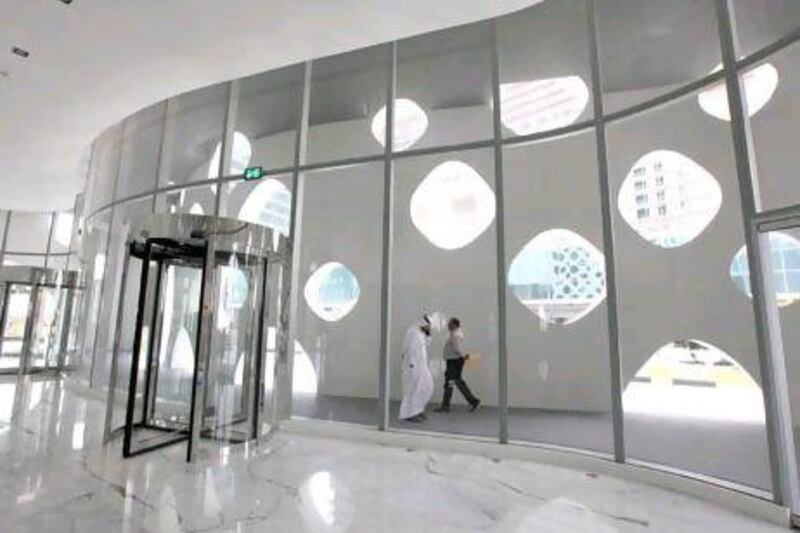Even in Dubai, where buildings curve and undulate, zig and zag, the 0-14 stands out.
Blogs: Crane Country
Last Updated: May 24, 2011
What's hot in property Read our Crane Country blog for a comprehensive picture of the property sector in the UAE and the wider Gulf region. Read blog
The 22-storey office block, known as the Swiss Cheese, in Business Bay is wrapped in a 40-centimetre "exoskeleton" of white concrete punched with 1,300 holes.
There is nothing like it … and that was the goal from the beginning. "The design was initially intended from an aesthetic point of view," says Shahab Lutfi, the chief executive of H&H Developers, the tower's builder. "That was our brief [to the architect], we wanted something different."
But they soon discovered eco-friendly advantages to the design, created by RUR Architecture of New York, compared with some of the steel and glass towers dotting the Dubai skyline, says Jesse Reiser, a partner in RUR.
"It was as if building in the hot and humid environment of the Gulf did not matter," Mr Reiser says.
The outer wall was designed to mimic Arabian screens known as mashrabiya, creating a veil around the building to provide shade and block the desert's heat and glare. The concrete skin brings a modern approach to a classic element of Middle East architecture.
What the designers did not expect was an energy-saving phenomenon created by the gap between the concrete skin and the main building. The distance was initially designed to allow room for the windows to be cleaned, Mr Reiser points out.
But to their surprise, the space created a vacuum, allowing cool air to filter through the holes of the concrete wall. This forced the hot air up and away from the inner tower, reducing the cooling costs by 30 per cent, the architects estimate.
"This is also a phenomenon typical in nature where primary mutations have unintended but beneficial secondary effects," Mr Reiser says.
The outer concrete and steel skin also plays a fundamental role in supporting the inner tower with an array of linking beams. Eliminating the interior pillars from the inner tower creates greater space, and more areas for rent. But constructing a building with a unique design presented an array of challenges.
"It was one of the hardest buildings to build," Mr Lutfi says. "Don't underestimate the complexities."
The development began in 2007, shortly before the global financial meltdown brought most of Dubai's new construction to a standstill.
"It was too late to stop," Mr Lutfi says. "Plus we had already sold most of the units."
There was also a "steep learning curve" in creating the weave of steel rebar for the concrete framework. It took several experiments with pouring the concrete before a system was perfected to create the wall with its distinctive holes.
While most buildings go through mutations in the building process, tweaks here and there to save money, the concrete framework for the Swiss Cheese tower was "virtually resistant" to changes. "Since 0-14 is not component-based like normal curtain wall towers, it was practically impossible to take anything away," Mr Reiser says. "Therefore the design you see was essentially unchanged from [drawing board] to execution."
About 2,500 tonnes of steel was needed for the tower, which cost Dh170 million (US$46.2m) to construct. To help to cut costs, building materials were imported from China. "Generally people look at it and say, why did you spend so much money on the external space?" Mr Lutfi says.
But he thinks the extra expense was worth it. The design attracts attention and that was the goal. "You either love or hate this building," he adds. "The majority of people love it."
About 90 per cent of the tower has already been sold, Mr Lutfi says But only about a quarter of it is occupied, which is fairly typical of Business Bay because it is still in the early construction phases.
Primary construction on 0-14 was completed last year. But the power was not hooked up until this spring, part of the infrastructure issues that have delayed several projects in Business Bay.
The name 0-14 comes from the number of the building's land plot in Business Bay, as well as a desire to create a moniker that suits the building's futuristic look.
Although the Swiss Cheese name has stuck, many observers have compared the design to a desert plant, and cannot tell if it is an old or new building, Mr Reiser says.
"It seemed to hold the skyline in a different way; not as an alien transplant but rather as a structure that resonated with its environment," he adds.





